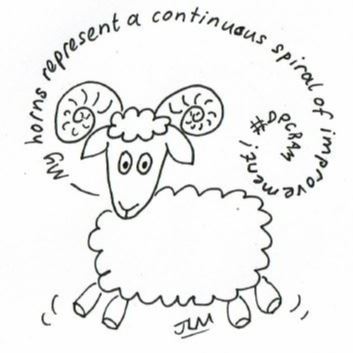This week, version 2 of DPC RAM, our Rapid Assessment Model was launched (including a new DPC RAM logo courtesy of Sharon McMeekin).
This blog post describes what has changed and why.
When DPC’s Rapid Assessment Model was first launched in September 2019 we were aware that future revisions would be required to keep it up-to-date. In an evolving field like digital preservation, good practice develops over time and the models by which we measure ourselves should also change in order to remain relevant.
Since the release of RAM we have been noting down any feedback we have received and storing these comments (and some of our own ideas) to revisit when it was time for a revision.
That time has come!
Whilst wanting to ensure that DPC RAM remained current, relevant and a reflection of good practice we were also on a mission to keep our editing to a minimum. One of the selling points of a maturity model such as DPC RAM is the ability to use it for continuous improvement - monitoring progress over time. With this in mind, it was agreed that no dramatic changes to the structure of the model would be made.
The revised version of RAM therefore retains its 11 sections and 5 maturity levels, and the headings of these sections and names of the maturity levels remains the same.
The revision was also carried out with an eye on the original guiding principles that were set out when DPC RAM was first created. In particular that it should remain:
- Applicable for organizations of any size and in any sector
- Applicable for all content of long-term value
- Preservation strategy and solution agnostic
Our edits have focused on the following:
- adding additional examples to maturity levels 2 to 4 to address gaps in coverage
- making small clarifications to the existing text
- ensuring greater consistency across the model (in a couple of cases shifting some of the bullet point examples between sections or levels)
So, what exactly has changed? Some of the most significant changes are described below, but of course it isn’t possible to describe every change in this blog post. If you are interested in the finer detail, we have a version of the model with our changes highlighted .
Environmentally sustainable preservation
Last year the DPC held a thought provoking webinar discussing how institutions who carry out digital preservation can reduce their impact on the environment and this really made us think. We hoped that this webinar wouldn’t be a one off activity and intended to return to the topic at some point in the future... and it occurred to us at the time that incorporating some of these ideas into DPC RAM would be a valuable exercise.
It was noted in the article by Keith Pendergrass, Walker Sampson, Tessa Walsh and Laura Alagna that prompted the webinar, that “digital preservation frameworks and standards reflect the focus on striving for optimal management”. They argued that “only by reevaluating what is required for successful digital preservation, and shifting to a model where management, successful use, and environmental sustainability are explicitly integrated into decision-making criteria, can the profession create sustainable digital preservation.”
DPC RAM has always been (and always will be) focused on continuous improvement, but we do also try to emphasise that not everyone should necessarily strive for the top level. This is an important point when thinking about environmental sustainability. The more that we keep, the more storage locations in place, the more normalization that we do, the more integrity checks we carry out, the greater the impact on the environment. That is not to say that you shouldn't do all of these things, but that you should make informed decisions, weighing up the risks of doing less with the impacts of doing more.
Our edits to DPC RAM encourage organizations to make carefully considered choices, in which the value of the content, risks to that content, and costs of action (both financial and environmental) are weighed up in order to reach an appropriate strategy. The concept of reapprasial is also introduced into model.
User needs
It was noted in feedback received that DPC RAM did not place enough emphasis on user needs and it is recognised that this is a really key part of working effectively in digital preservation. Most digital preservation questions we are asked invariably come back to a question about what is needed by the users or what current or future use case we are trying to support.
To this end, the importance of understanding user needs has been brought out more strongly within the model, both as an input to inform digital preservation policy and procedure and as a factor to consider when considering preservation action.
Ensuring the meaning and functionality of content is maintained
Another gap highlighted relates to ensuring the meaning and functionality of content is maintained. Though the ‘Content preservation’ section of RAM was described as relating to processes to preserve the meaning or functionality of the digital content, these points weren’t brought out very strongly in the examples given. New examples have been added to address this gap.
Legal basis
One of the sections which we have given the most attention to in our revision is ‘Legal basis’. Some of the feedback we had received on RAM suggested that this section was a bit lightweight. Revising this section was quite a challenge given our principle of keeping the model applicable to all regardless of sector or geographic location. We were wary of falling into the trap of delving into too many specifics, and wanted to keep the examples broad enough to be widely relevant and applicable. In particular we found the description of this section was veering towards being too specific so the wording has been changed and it now incorporates relevant regulation and adherence to ethical codes as well as legal rights and responsibilities. Accessibility requirements are another new addition to this section.
Acquisition, transfer and ingest
This section has also had a significant overhaul. One particular goal we had for this section was to make it more widely applicable to those who are not in the traditional archiving sector. To this end, we have added some examples that relate to those organizations who are preserving their own business records rather than accepting content from donors and depositors.
Time frame for targets
The templates for recording a DPC RAM assessment remain largely unchanged, but have been edited to allow users to record a time frame for the target levels that are set. It is clear from talking to users of the model that different people use different time frames for their targets. Some think about where they want to be in 12 months time, others specify longer time periods (3-5 years) and others are working towards an unspecified point in the future. This is fine, but makes the comparison and benchmarking that we do across the DPC Membership more challenging. After some research on how the community likes to use maturity models (actually just a little Twitter poll), it was agreed that we should keep it flexible and encourage people to use whatever time frame works best in their own context. The only change we have made is to provide a box for people to specify which time frame they have used.
A big thank you to...
We are indebted to members of the community who have provided feedback on DPC RAM. Particular thanks go to Herve L’Hours and Simon Wilson who’s detailed and insightful comments really helped inform this new version. We are also grateful to members of the DPC Research and Practice subcommittee and Adrian Brown for reviewing our revisions to DPC RAM prior to this release. Thanks also to all of my colleagues at the DPC. This was a real team effort with everyone involved in helping to shape and release RAM version 2 in one way or another. Thanks all!
Feedback welcome
This is the first revision to the Rapid Assessment Model but it won’t be the last. We are keen to continue to gather feedback about DPC RAM so we can ensure it remains a current and useful resource for the digital preservation community. To this end we have added a feedback form to the DPC RAM web pages to collect your thoughts. As always, we'd love to hear from you!
































































































































Read more...